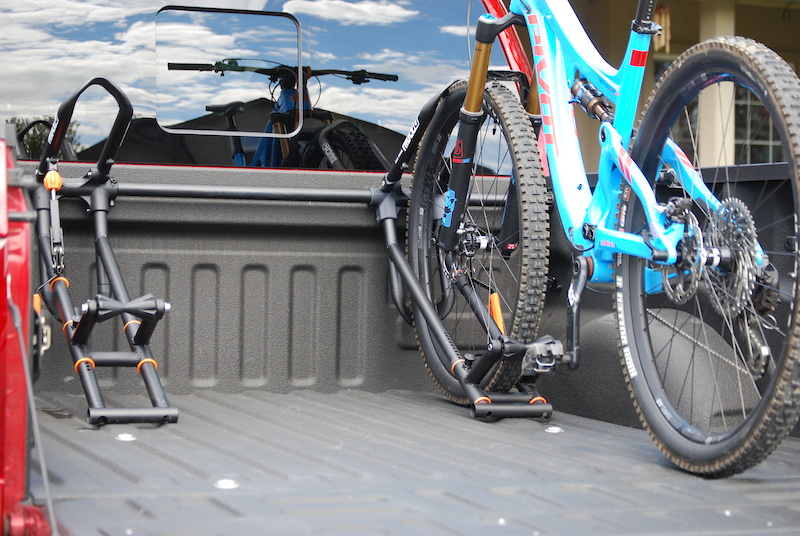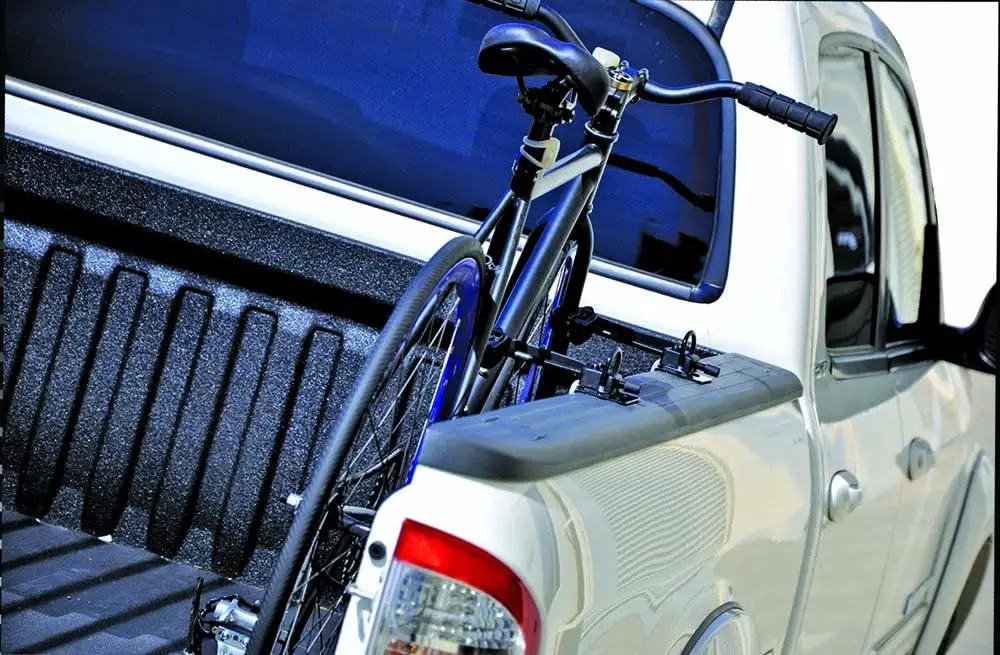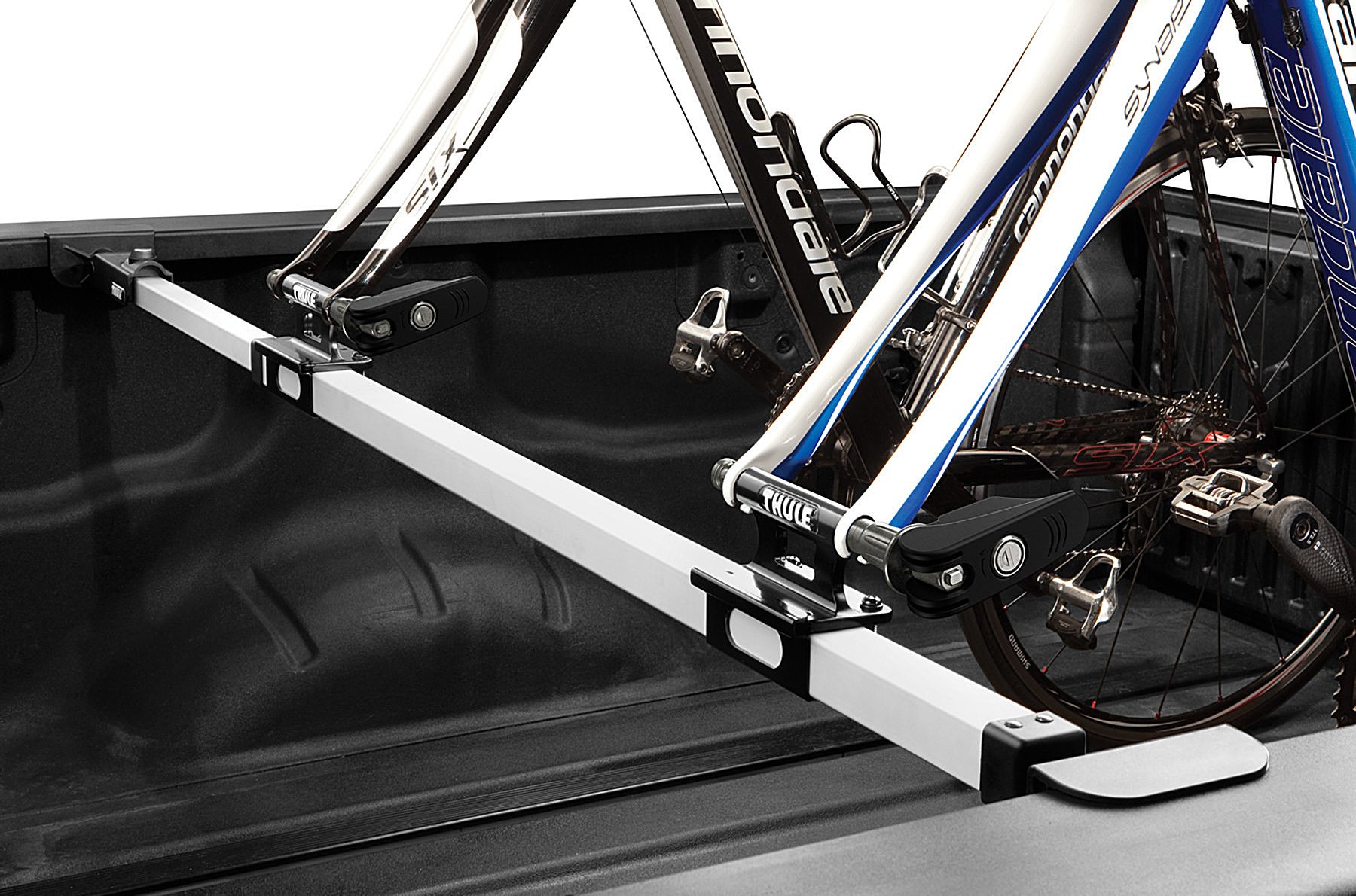Identifying the Ideal Bike Rack for Your Pickup Truck
Selecting the best bike rack for a pickup truck is a crucial decision that depends on several factors. The model and size of your truck, the number of bikes you intend to carry, and your preferences for ease of use, security, and affordability should all be taken into account. A well-chosen bike rack can ensure the safe and convenient transportation of your bikes while minimizing any impact on your truck’s performance.
Understanding the Different Types of Bike Racks for Pickup Trucks
When searching for the best bike rack for a pickup truck, it’s essential to understand the various categories available. Each type has its unique advantages and disadvantages, making it crucial to consider your specific needs and preferences. The primary options include truck bed mounts, hitch-mounted racks, and spare tire mounts.
Truck Bed Mounts
Truck bed mounts are designed to securely hold bikes within the bed of a pickup truck. These mounts often feature adjustable arms or cradles to accommodate various bike frame sizes and designs. They are known for their ease of use, enhanced security, and minimal impact on the truck’s towing capacity. However, they may require additional space in the truck bed, potentially limiting cargo room.
Hitch-Mounted Racks
Hitch-mounted racks are popular for their ease of installation and adaptability to various truck models. They attach to the truck’s receiver hitch, providing a stable platform for carrying bikes. Hitch-mounted racks can carry multiple bikes and often include features for improved security and stability. Nevertheless, they may affect the truck’s ground clearance and require proper load distribution to prevent damage to the vehicle.
Spare Tire Mounts
Spare tire mounts are compact, space-saving solutions that attach to the truck’s spare tire. These mounts are ideal for off-road enthusiasts, as they keep bikes clear of the truck’s body and minimize the risk of damage. However, spare tire mounts may have limited capacity and compatibility with specific truck models. It’s essential to ensure that the mount is compatible with your truck’s spare tire and suspension system.
Truck Bed Mounts: Secure and Accessible Bike Transport
Truck bed mounts are a popular choice for those seeking a secure and accessible bike transport solution. These mounts are designed to fit inside the bed of a pickup truck, providing a stable platform for carrying bikes. They offer several benefits, including easy loading and unloading, enhanced security, and minimal impact on the truck’s towing capacity.
One advantage of truck bed mounts is their straightforward installation process. They typically require no drilling or modification to the truck, making them a non-permanent and easily removable option. Additionally, many models are adjustable, accommodating various bike frame sizes and designs. This flexibility ensures that your bikes remain secure and undamaged during transportation.
Two popular truck bed mount options are the Thule Insta-Gater Truck Bed Bike Mount and the Yakima BlockHead. The Thule Insta-Gater features a quick-attach cam system that secures the bike to the mount, while the Yakima BlockHead uses a ratcheting wheel strap to hold the bike in place. Both products offer excellent security and ease of use, making them strong contenders for the best bike rack for a pickup truck.
However, truck bed mounts do have some limitations. They may require additional space in the truck bed, potentially limiting cargo room. Additionally, users may need to remove the front wheel of their bike to use some mounts, adding an extra step to the loading process. Despite these minor drawbacks, truck bed mounts remain a reliable and convenient option for transporting bikes in a pickup truck.
Hitch-Mounted Racks: Convenient and Versatile Bike Carriers
Hitch-mounted racks offer a convenient and versatile solution for transporting bikes on a pickup truck. These racks attach to the truck’s receiver hitch, providing a stable platform for carrying bikes. Hitch-mounted racks are known for their ease of installation, adaptability to various truck models, and capacity to carry multiple bikes.
One of the primary advantages of hitch-mounted racks is their straightforward installation process. They typically require no drilling or modification to the truck, making them a non-permanent and easily removable option. Additionally, many models can fold up or down when not in use, allowing for easy access to the truck’s tailgate or cargo area. This flexibility ensures that hitch-mounted racks can accommodate various truck models and user preferences.
Two notable hitch-mounted rack options are the Kuat Transfer v2 and the Swagman XC Cross-Country 2-Bike Hitch Mount. The Kuat Transfer v2 features a quick-release tilt lever for easy access to the truck’s cargo area, while the Swagman XC Cross-Country 2-Bike Hitch Mount offers a ratcheting arm system for secure bike attachment. Both products provide excellent security, ease of use, and adaptability, making them strong contenders for the best bike rack for a pickup truck.
However, hitch-mounted racks do have some limitations. They may affect the truck’s ground clearance and require proper load distribution to prevent damage to the vehicle. Additionally, users must ensure that the rack and bikes do not exceed the truck’s towing capacity or the hitch receiver’s weight limits. Despite these minor drawbacks, hitch-mounted racks remain a reliable and convenient option for transporting bikes in a pickup truck.
Spare Tire Mounts: Space-Saving Bike Rack Solutions
Spare tire mounts offer a space-saving solution for transporting bikes on a pickup truck. These racks attach to the truck’s spare tire, providing a compact platform for carrying bikes. They are well-suited for off-road enthusiasts, as they keep bikes clear of the truck’s body and minimize the risk of damage. Additionally, spare tire mounts are compatible with most pickup trucks and often feature a straightforward installation process.
One advantage of spare tire mounts is their minimal impact on the truck’s towing capacity and ground clearance. They typically have a lower profile than other bike rack options, allowing for better clearance when driving off-road or navigating tight spaces. Furthermore, spare tire mounts often provide easy access to the truck’s cargo area, making them a convenient choice for users who need to transport both bikes and gear.
Two notable spare tire mount options are the Hollywood Racks SR1 Spare Tire Rack and the Surco 632 Cup Spare Tire Bike Rack. The Hollywood Racks SR1 features a durable construction and a quick-release system for easy bike attachment, while the Surco 632 Cup Spare Tire Bike Rack offers a unique design that accommodates up to two bikes and includes a built-in locking system for added security.
However, spare tire mounts do have some limitations. They may have limited capacity and compatibility with specific truck models. Additionally, users must ensure that the mount and bikes do not exceed the truck’s towing capacity or the spare tire’s weight limits. Despite these minor drawbacks, spare tire mounts remain a reliable and convenient option for transporting bikes in a pickup truck, particularly for off-road enthusiasts seeking a space-saving solution.
How to Choose the Best Bike Rack for Your Pickup Truck
Selecting the ideal bike rack for a pickup truck involves careful consideration of several factors. These factors include compatibility, capacity, ease of use, security, and price. By following this comprehensive checklist, you can ensure that you find the best bike rack for your pickup truck, meeting your specific needs and preferences.
Assessing Compatibility
First, determine whether the bike rack is compatible with your pickup truck model. Consider the truck’s bed size, hitch receiver dimensions, and spare tire specifications, depending on the type of bike rack you are considering. Some racks may require additional adapters or modifications for proper installation.
Evaluating Capacity
Next, consider the number of bikes you need to transport and the rack’s carrying capacity. Ensure that the rack can accommodate the required number of bikes without exceeding the truck’s towing capacity or the rack’s weight limits.
Prioritizing Ease of Use
Ease of use is another critical factor when choosing a bike rack for a pickup truck. Look for racks with user-friendly features, such as quick-release systems, tool-free installation, and adjustable cradles or arms. These features can simplify the loading and unloading process and make the rack more convenient to use.
Securing Your Bikes and Truck
Security is essential when transporting bikes in a pickup truck. Opt for racks with built-in locking mechanisms or the ability to add aftermarket locks. This ensures that your bikes remain secure during transit and prevents theft. Additionally, ensure that the rack itself is securely attached to the truck, minimizing the risk of damage or accidents.
Comparing Prices
Lastly, compare prices and features of various bike racks to find the best value for your money. While it may be tempting to choose the most affordable option, investing in a high-quality, durable rack can save you money in the long run by reducing the need for frequent replacements or repairs.
By carefully evaluating these factors, you can find the best bike rack for a pickup truck, ensuring safe and convenient transportation for your bikes. Remember to measure your truck’s bed size, hitch receiver, or spare tire specifications and assess the bike’s frame dimensions before making a final decision.
Maximizing Safety and Security: Best Practices for Installing and Using Bike Racks
When using a bike rack for a pickup truck, it’s essential to prioritize safety and security for both the bikes and the vehicle. By following these guidelines, you can ensure a secure and worry-free transportation experience.
Proper Installation
Begin by carefully reading and following the manufacturer’s instructions for installing the bike rack. Ensure that all components are securely fastened and that the rack is properly aligned with the truck’s bed, hitch receiver, or spare tire. Periodically check the rack’s stability and tightness during transit, especially if you are traveling over rough terrain or at high speeds.
Locking Mechanisms
Choose a bike rack with built-in locking mechanisms or the ability to add aftermarket locks. This ensures that your bikes remain secure during transit and prevents theft. When using locks, secure the bikes to the rack and the rack to the truck, minimizing the risk of damage or accidents.
Load Distribution
Properly distribute the weight of the bikes on the rack to prevent damage to the truck or the bikes. Avoid overloading the rack or exceeding the truck’s towing capacity or the rack’s weight limits. Ensure that the bikes are securely fastened and that they do not obstruct the truck’s mirrors, lights, or license plates.
Weight Limits
Be aware of the weight limits of your bike rack and the truck. Exceeding these limits can lead to damage, accidents, or reduced vehicle performance. Regularly inspect the rack and the truck for signs of wear, strain, or damage, and address any issues promptly.
Additional Security Measures
Consider adding additional security measures, such as cable locks or wheel locks, to further deter theft and ensure the safety of your bikes. These measures can provide an extra layer of protection, especially when leaving the truck and bikes unattended in public areas.
By following these guidelines, you can maximize safety and security when using a bike rack for a pickup truck. Proper installation, locking mechanisms, load distribution, and weight limits are all critical factors in ensuring a secure and worry-free transportation experience.
Maintaining Your Bike Rack: Tips for Long-Term Use and Durability
Regular maintenance is crucial for ensuring the longevity and optimal performance of your bike rack for a pickup truck. By following these tips, you can keep your rack in excellent condition and avoid potential issues or damages.
Cleaning
Clean your bike rack regularly to remove dirt, debris, and grime. Use a mild soap and warm water, and avoid using harsh chemicals that may damage the rack’s finish or components. Rinelyse the rack thoroughly and dry it completely to prevent rust or corrosion.
Lubrication
Lubricate any moving parts, such as hinges, latches, or locking mechanisms, to ensure smooth operation and prevent wear and tear. Use a high-quality lubricant specifically designed for bike racks or similar applications. Be sure to wipe away any excess lubricant to prevent attracting dirt or debris.
Inspection
Regularly inspect your bike rack for signs of wear, strain, or damage. Check the stability of the rack, the tightness of the fasteners, and the condition of the paint or finish. Address any issues promptly to prevent further damage or potential safety hazards.
Storage
When not in use, store your bike rack in a dry, secure location, protected from the elements and potential theft. If possible, disassemble the rack and store it in its original packaging or a dedicated bike rack storage bag. This can help prevent damage during storage and make transportation easier.
Repairs and Replacements
Promptly address any repairs or replacements needed for your bike rack. Replace worn or damaged parts as necessary, and consider upgrading or replacing the rack if it becomes severely damaged or outdated. Regular maintenance and timely repairs can help extend the life of your bike rack and ensure its continued performance.
By following these maintenance tips, you can keep your bike rack in excellent condition and ensure its longevity and optimal performance. Regular cleaning, lubrication, inspection, storage, and repairs are all essential aspects of maintaining your bike rack for a pickup truck.







